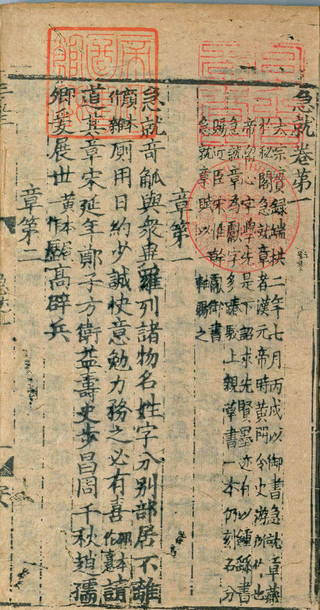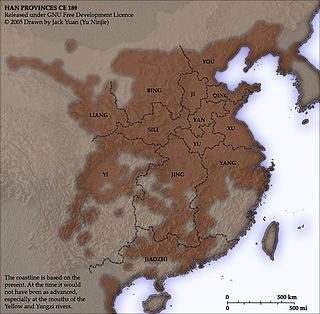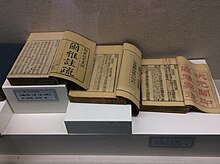
The Shuowen Jiezi is a Chinese dictionary compiled by Xu Shen c. 100 CE, during the Eastern Han dynasty. While prefigured by earlier Chinese character reference works like the Erya, the Shuowen Jiezi featured the first comprehensive analysis of characters in terms of their structure, and attempted to provide a rationale for their construction. It was also the first to organize its entries into sections according to shared components called radicals.
Fanqie is a method in traditional Chinese lexicography to indicate the pronunciation of a monosyllabic character by using two other characters, one with the same initial consonant as the desired syllable and one with the same rest of the syllable . The method was introduced in the 3rd century AD and is to some extent still used in commentaries on the classics and dictionaries.

Xu Shen was a Chinese calligrapher, philologist, politician, and writer of the Eastern Han dynasty. During his own lifetime, Xu was recognized as a preeminent scholar of the Five Classics. He was the author of Shuowen Jiezi, which was the first comprehensive dictionary of Chinese characters, as well as the first to organize entries by radical. This work continues to provide scholars with information on the development and historical usage of Chinese characters. Xu Shen completed his first draft in 100 CE but, waited until 121 CE before having his son present the work to the Emperor An of Han.

Qiulong or qiu was a Chinese dragon that is contradictorily defined as "horned dragon" and "hornless dragon".
The Shiming, also known as the Yiya, is a Chinese dictionary that employed phonological glosses, and is believed have been composed c. 200 CE. Because it records the pronunciation of an Eastern Han Chinese dialect, sinologists have used the Shiming to estimate the dates of sound shifts, such as the loss of consonant clusters that took place between the Old Chinese and Middle Chinese stages.
The Guangya was an early 3rd-century CE Chinese dictionary, edited by Zhang Yi (張揖) during the Three Kingdoms period. It was later called the Boya owing to naming taboo on Yang Guang (楊廣), which was the birth name of Emperor Yang of Sui.
The Xiao Erya was an early Chinese dictionary that supplements the Erya. It was supposedly compiled in the early Han dynasty by Kong Fu, a descendant of Confucius. However, the received Xiao Erya text was included in a Confucianist collection of debates, the Kongcongzi, which contains fabrications that its first editor Wang Su added to win his arguments with Zheng Xuan. The Qing dynasty scholar Hu Chenggong, who wrote the Xiao Erya yizheng, accepted Kong Fu as the author. Liu concludes the Xiao Erya reliably dates from the Western Han dynasty and suggests its compiler was from the southern state of Chu.
The Piya was a Chinese dictionary compiled by Song Dynasty scholar Lu Dian. He wrote this Erya supplement along with his Erya Xinyi commentary. Although the Piya preface written by his son Lu Zai (陸宰/陆宰) is dated 1125, the dictionary was written earlier; estimates around the Yuanfeng era, and Joseph Needham says around 1096.

There are two types of dictionaries regularly used in the Chinese language: 'character dictionaries' list individual Chinese characters, and 'word dictionaries' list words and phrases. Because tens of thousands of characters have been used in written Chinese, Chinese lexicographers have developed a number of methods to order and sort characters to facilitate more convenient reference.
Teng or Tengshe is a flying dragon in Chinese mythology.
Yangzhou, Yangchow or Yang Province was one of the Nine Provinces of ancient China mentioned in historical texts such as the Tribute of Yu, Erya and Rites of Zhou.
Pu is a Chinese word meaning "unworked wood; inherent quality; simple" that was an early Daoist metaphor for the natural state of humanity, and relates with the Daoist keyword ziran "natural; spontaneous". The scholar Ge Hong immortalized pu in his pen name Baopuzi "Master who Embraces Simplicity" and eponymous book Baopuzi.
The Shenglei 聲類, compiled by the Cao Wei dynasty lexicographer Li Deng 李登, was the first Chinese rime dictionary. Earlier dictionaries were organized either by semantic fields or by character radicals. The last copies of the Shenglei were lost around the 13th century, and it is known only from earlier descriptions and quotations, which say it was in 10 volumes and contained 11,520 Chinese character entries, categorized by linguistic tone in terms of the wǔshēng 五聲 "Five Tones " from Chinese musicology and wǔxíng 五行 "Five Phases/Elements" theory.

The (1254) Zitong 字通 or Mastery of Characters is a Chinese dictionary of orthography that was compiled by the Southern Song dynasty (1127-1279) scholar Li Congzhou 李從周. It discussed logographic differences among Chinese characters written in the ancient Qin dynasty seal script, standard Han dynasty clerical script, and contemporary Song regular script.
The Cangjiepian, also known as the Three Chapters, was a c. 220 BCE Chinese primer and a prototype for Chinese dictionaries. Li Si, Chancellor of the Qin dynasty, compiled it for the purpose of reforming written Chinese into the new orthographic standard Small Seal Script. Beginning in the Han dynasty, many scholars and lexicographers expanded and annotated the Cangjiepian. By the end of the Tang dynasty (618–907), it had become a lost work, but in 1977, archeologists discovered a cache of texts written on bamboo strips, including fragments of the Cangjiepian.

The Jijiupian is a Chinese character primer that was compiled by the Han dynasty scholar Shi You around 40 BCE. Similar to an abecedarium, it contains a series of orthographic word lists, categorized according to character radical, and briefly explained in rhymed lines. In the Qin and Han dynasties, several similar othographic primers were in circulation, such as Cangjiepian, but the Jijiupian is the only one that survived for two millennia.

The Yiqiejing yinyi is the oldest surviving Chinese dictionary of technical Buddhist terminology, and the archetype for later Chinese bilingual dictionaries. This specialized glossary was compiled by the Tang dynasty lexicographer and monk Xuanying (玄應), who was a translator for the famous pilgrim and Sanskritist monk Xuanzang. When Xuanying died he had only finished 25 chapters of the dictionary, but in 807 another Tang monk named Huilin (慧琳) compiled an enlarged 100-chapter version bearing the same title.

The Yiqiejing yinyi 一切經音義 "Pronunciation and Meaning in the Complete Buddhist Canon" was compiled by the Tang dynasty lexicographer monk Huilin 慧琳 as an expanded revision of the original Yiqiejing yinyi compiled by Xuanying 玄應. Collectively, Xuanying's 25-chapter and Huilin's 100-chapter versions constitute the oldest surviving Chinese dictionary of Buddhist technical terminology. A recent history of Chinese lexicography call Huilin's Yiqiejing yinyi "a composite collection of all the glossaries of scripture words and expressions compiled in and before the Tang Dynasty" and "the archetype of the Chinese bilingual dictionary".

Eastern Han Chinese, Later Han Chinese or Late Old Chinese is the stage of the Chinese language revealed by poetry and glosses from the Eastern Han period . It is considered an intermediate stage between Old Chinese and the Middle Chinese of the 7th-century Qieyun dictionary.

Xué Ér (學而) is the first book of the Analects of Confucius. According to Zhu Xi, a Confucian philosopher in the 12th century, the book Xue Er is the base of moral improvement because it touches upon the basic principles of being a "gentleman".








